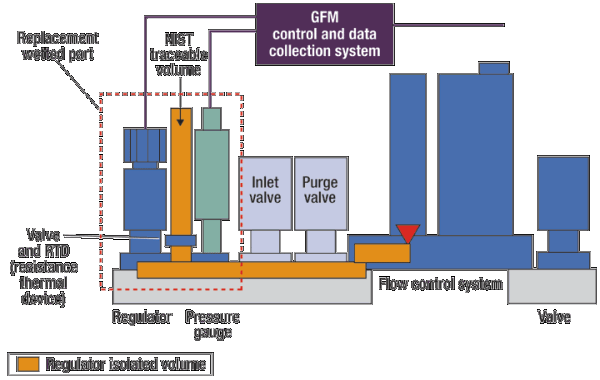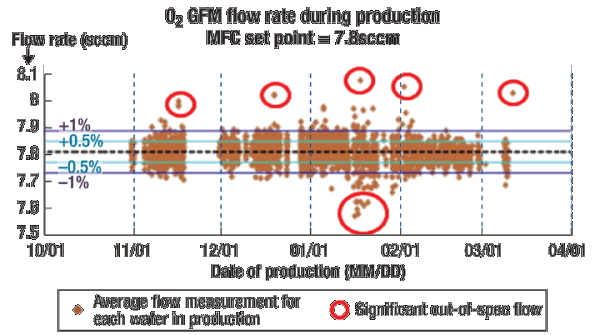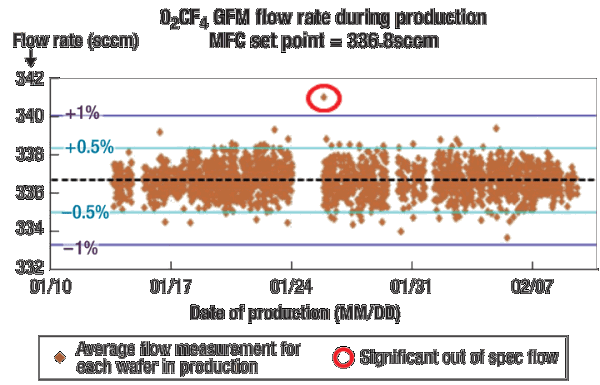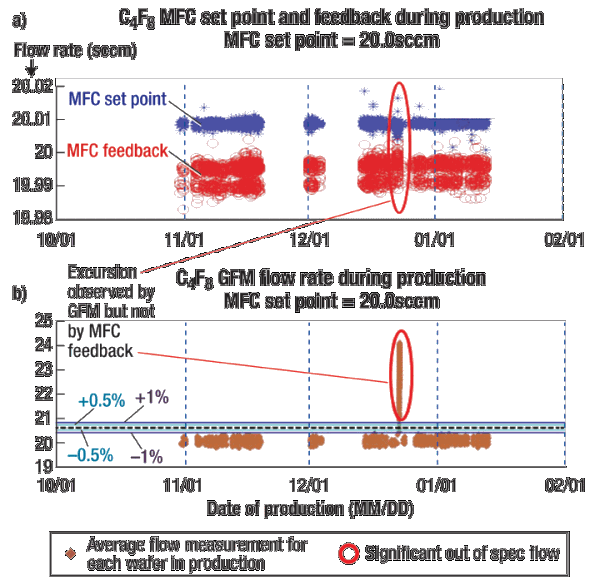|
Executive Overview As the industry continues to scale, the performance of a tool’s gas flow delivery system is becoming increasingly important. Next-generation processes are putting demands on gas flow control that leading-edge mass flow controller (MFC) technologies are struggling to meet. As a result, accurate monitoring and control of the variations in gas flow is vital to ensure process stability, maximize yield, and increase tool productivity. This article outlines an approach for improving etch equipment performance through a high accuracy in situ gas flow monitoring system and control scheme. |
Mukund Venkatesh, Joseph Monkowski, Pivotal Systems, Pleasanton, CA USA; Kevin Boyd, IBM, Hopewell Junction, NY USA
Gas flow accuracy and repeatability wafer to wafer and chamber to chamber are becoming increasingly important at the 45nm technology node and beyond. Smaller dimensions and feature sizes demand low gas flow rates (e.g., as low as 2sccm) with tight accuracy requirements (±0.5% vs. ±1% deviation of set point). Defectivity is also a major concern as nodes shrink. One of the major gains in reactive ion etch (RIE) defectivity has been the implementation of continuous plasma to avoid blocked etch conditions; IBM has seen a significant reduction in "missing pattern" defects by implementing continuous plasma processing (i.e., no plasma off stability steps) throughout the BEOL etch sector. The one drawback to continuous plasma is the increased process variation created due to gas flow transients and flow reaction time variability (typically within first ~5 seconds of flow turn on or flow rate change). The removal of stability steps coupled with existing gas flow transients makes any chamber to chamber variability more apparent when, for example, looking at trench critical dimensions. As a result, being able to measure real-time gas flow ramp between steps and stabilization time after gas turn on is critical to match chambers as the critical dimensions and tolerances get tighter to meet advanced device demands.
Challenging MFC specs
While other subcomponent systems, such as power delivery, chamber temperature, and chamber pressure, are effectively monitored and controlled with sufficient accuracy, latest-generation mass flow controller (MFC) subcomponent systems are struggling to keep up. Best-in-class MFC accuracy specifications are ±1% of set point and have wider accuracy performance ranges when pushed to low flows (e.g., <10-30% of full scale flow) unless very specific low-flow MFCs can be afforded within the gas box. MFC turn-on or flow-change transients are also not detectable since the MFC’s feedback signal does not report this initial behavior to any degree of accuracy or time resolution. MFC calibration techniques are also lacking in their ability to help resolve these limitations. All known methods, including the industry standard pressure rise measurement of gas flowing into a known volume, are "off-line" approaches, thereby precluding any possibility of understanding, monitoring and controlling against wafer level gas flow variations.
As a result of these challenges, within etch, plenty of time and resources are spent troubleshooting and maintaining gas flow delivery systems. Gas flow issues, for example, can account for more than 30% of scrap within a typical BEOL etch module. Additionally, pareto analyses of yield and chamber matching issues consistently put gas flow delivery as one of the top problem areas. Finally, in tool capacity planning, a single digit percentage of etch tool availability is automatically reserved for off-line gas calibration activities.
In situ gas flow monitoring and control
One approach to address this need is through the adoption of an in situ gas flow monitoring (GFM) system. The GFM system measures an induced rate of pressure drop within the gas stick upstream of the MFC over a known volume and temperature during wafer processing. The method is based upon first principles, specifically:
PV = nZRT
Where:
• P is the absolute pressure of the gas
• V is the volume of the gas
• n is the number of moles of the gas
• R is the universal gas constant
• T is the absolute temperature
• Z is the compressibility factor
Therefore:
n = P V/ZRT
And finally:
?n = ?P V/ZRT
As such, the GFM system offers a primary standard measurement of gas flow (NIST traceable) and has an accuracy specification of ±0.5%. The system (Fig. 1) consists of a wetted part that replaces the existing regulator and pressure transducer on a typical gas stick (combines the function of regulator, pressure reading, temperature reading, and NIST-traceable volume measurement) and a GFM control/data collection system installed outside of the gas box.
 |
|
Figure 1. The Gas Flow Monitor (GFM) system includes a replacement wetted part on the gas stick connected to a control/data collection system installed outside the gas box. (Source: Pivotal Systems) |
Every time an MFC turns on or changes flow, the GFM system immediately measures the induced pressure drop and calculates the average flow rate for that recipe step. Given the system’s response time of 50ms, MFC average flow measurements can be taken within seconds and transient flow measurements within the first ~3 seconds can be seen with ease. Most importantly, the measurement approach is transparent to and does not affect the performance of the MFC during wafer processing. Both pressure insensitive (PI) and non PI MFCs have been tested to show them well equipped to handle this small induced pressure drop from the GFM system.
Armed with GFM data by gas, etch step, wafer and chamber, optional control schemes are pursued for enhanced automated tool control. When an MFC is observed to be out-of-flow specification during wafer processing, these automated control schemes include: 1) Alerting equipment engineers, 2) Stopping wafer processing, 3) Recalibrating the troubled MFC, and 4) Changing MFC set point for subsequent wafer (feedback control).
High volume production implementation
The GFM system described above is currently installed in high-volume production on leading-edge plasma etch oxide systems at IBM’s Fishkill facility. These etch systems use leading-edge PI pressure-based MFCs (±1% of set point). While all gases are monitored by the system, the wafer etch process is particularly sensitive to O2, CF4, CH2F2 and C4F8, and therefore these are studied in great detail. For each gas, GFM data is captured for each step of each recipe of each wafer processed. An alarm control scheme was implemented to automatically halt wafer processing in the event that gas flows are observed to be out-of-spec for a particular MFC set point.
The new system has highlighted and averted a number of gas flow related process yield issues that otherwise would have gone undetected for long periods of time. Some sample issues are described below:
1. Out of spec MFC perturbations: Many of the MFCs showed a fair amount of out-of-spec performance (both above and below ±1% of set point). Occasionally the out-of-spec runs would occur in clumps as this O2 production flow indicates (Fig. 2)
 |
| Figure 2. A low flow O2 MFC was observed to be out-of-spec on a number of production runs. At one point, a clump of low flow outliers is witnessed. (Source: IBM) |
2. Varying MFC turn on/flow change transients and settling times: The GFM system observed varying turn-on and flow change transients from run to run and MFC to MFC. For example, after long periods of idle time on the chamber, the first wafer processed witnessed a consistently higher out-of-spec flow rate due to an abnormal MFC settling characteristic (Fig. 3)
 |
| Figure 3. The GFM system indicated on multiple gas sticks that after long periods of chamber idle time, the first wafer processed witnessed a consistently higher out-of-spec flow rate due to an abnormal MFC settling characteristic. (Source: IBM) |
3. MFC perturbations due to gas supply: One particular yield excursion that hurts yield on many tools was due to a gas supply change on C4F8. The supply pressure was poorly set, leading to improper flows from the pressure-based MFC. GFM immediately registered the flow variation even though the MFC indicated it was flowing accurately (Fig. 4)
 |
| Figure 4. Due to an improper gas supply pressure setting, a number of C4F8 MFCs went out-of-spec. While the MFC reported in-spec operation, GFM immediately registered the significant flow excursion. (Source: IBM) |
4. MFC drift behavior: For one particular CH2F2 MFC, a gradual drift towards out of spec flow was observed over successive production runs
An additional benefit is that the GFM system has eliminated the need for off-line calibration thereby freeing up the single digit percentage of tool time availability and increasing wafer throughput.
Conclusion
The above benefits comprise a compelling ROI and IBM’s end goal is to implement a feed-back control system that will automatically adjust etch recipe gas flow set points based on the GFM measurement of the previous wafer. The expectation is that variation in key in-line parameters such as CD from chamber to chamber will reduce significantly.
Acknowledgments
GFM is a trademark of Pivotal Systems.
Biographies
Mukund Venkatesh is VP of Marketing at Pivotal Systems, 4683 Chabot Drive, Pleasanton, CA 94588; ph.: +1-925-924-1480 ext. 203; email [email protected].
Joseph Monkowski is President and CTO at Pivotal Systems.
Kevin Boyd received his BS in chemical engineering from Worcester Polytechnic Institute and is an advisory engineer at IBM, Hopewell Junction, NY USA.
More Solid State Technology Current Issue Articles
More Solid State Technology Archives Issue Articles

